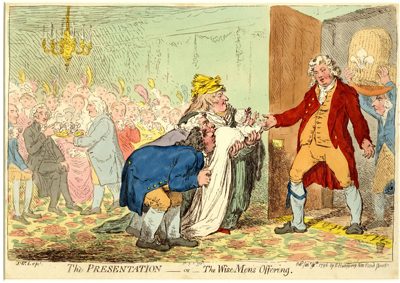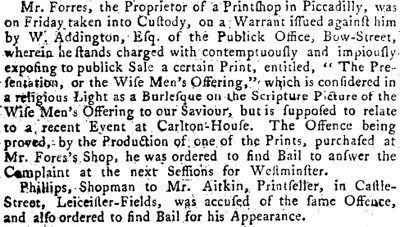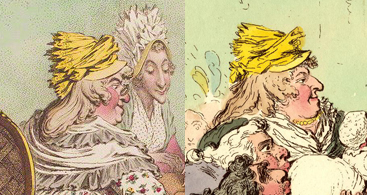The Presentation, or The Wise Men's Offering
Commentary on The Presentation has been overshadowed by the fact that, against all logic, this is the only print in Gillray's extensive and often incendiary corpus for which he was actually arrested. The January 22nd Evening Mail contained the first notice of the event.
On Saturday morning James Gillray, a Caricature Print-engraver, was brought before the sitting Magistrate; at the Public-office, Bow-street, charged with selling a certain burlesque Caricature Print, entitled "The Wise Man's Offering," which is a burlesque on the presenting [of] the infant Princess to the Prince of Wales, and several well-known characters are introduced. He was admitted to bail. (p. 3)

© Trustees of the British Museum
What is perhaps even more surprising is that according to the London Daily Advertiser, January 25, 1796, two other print sellers had been arrested for the same offense a day before Gillray's detainment.

London Daily Advertiser (January 25, 1796)
© Newspaper Archive
This is surprising for at least two reasons: 1) because the print seems tame by comparison with any number of Gillray prints attacking members of the the Royal Family; 2) because Samuel Fores and James Aitken were prosecuted for selling the print while Hannah Humphrey, the actual publisher of the print was not. In any case, whether as a result of political intervention or the fundmental absurdity of the charges, the prosecution seems never to have proceeded. (See Draper Hill for a complete account.)
The impetus for this print was the birth on January 7th, 1796 of Princess Charlotte, the first and only legitimate child of the Prince of Wales (the future George IV), and at the time (barring the birth of any future male child) the presumptive heir to the throne. The basic analogy of the print would have been suggested by the fact that January 6th was the Feast of the Epiphany, celebrating the "presentation" of the baby Jesus, the son of God, to the gentile world represented by the Magi or Wise Men. And it was, apparently, the profaning of a religious symbol, rather than the insulting portrayal of the Prince of Wales, that was at least the pretext for Gillray's arrest.
The scene (entirely fictional) is set at Carlton-House, the residence of the Prince. An array of gentlemen and ladies with fashionably plumed headdresses have assembled to celebrate the occasion. They are all drinking caudle, a hot (usually) alcoholic beverage containing eggs, bread, and various spices orginally provided to new mothers for its postpartum strengthening effect but later served ceremonially to guests at births and christenings. The Prince of Wales has just arrived, staggering into the room thoroughly drunk, his jacket open, vest partially unbuttoned, shoes untied, and stockings ungartered. He is followed by the Prince's friend and Whig MP, Michael Angelo Taylor, carrying a wicker cradle for the baby Princess. The "Wise Men" obseqiously kissing her bottom are the Whig leaders, Charles James Fox and Richard Brinsley Sheridan, whose relationship with the Prince ebbed and flowed with his mood and circumstances.
At the very center of the print is the woman holding Princess Charlotte. The British Museum describes her only as "a stout and florid woman." An annotation below the print (mentioned in the BM commentary) identifies her as Mrs. Fitzherbert." But I think it is clear (and crucial for the intent of the print) that the woman is, in fact, the well-known bawd, Mother Windsor who can be seen in Gillray's Push-Pin playing with the Duke of Queensberry for the reward of a young woman.

© National Portrait Gallery, London
Trustees of the British Museum
If I am right, then, the print is really about prostitution: the prostitution committed by the Prince of Wales in marrying and bedding (in a similarly drunken stupor) Charlotte's mother whom he openly despised; and the daily prostitution of Whigs in fawning before a drunken, self-indulgent, and faithless Prince.
Sources and Reading
- Commentary from the British Museum on The Presentation, or The Wise Men's Offering.
- Draper Hill, Mr. Gillray The Caricaturist, 1965, pp. 61, 62, 118 Pl. #66
- "Caudle," Wikipedia
- "Epiphany (holiday)," Wikipedia
- "Caroline of Brunswick," Wikipedia
- "Princess Charlotte of Wales," Wikipedia
- "Charles James Fox," Wikipedia
- "George IV of the United Kingdom," Wikipedia
- "Richard Brinsley Sheridan," Wikipedia
- Thomas Wright and R.H. Evans, Historical and Descriptive Account of the Caricatures of James Gillray #142.
- Thomas Wright and Joseph Grego, The Works of James Gillray, the Caricaturist; With the History of His Life and Times, p. 199.
Comments & Corrections
NOTE: Comments and/or corrections are always appreciated. To make that easier, I have included a form below that you can use. I promise never to share any of the info provided without your express permission.